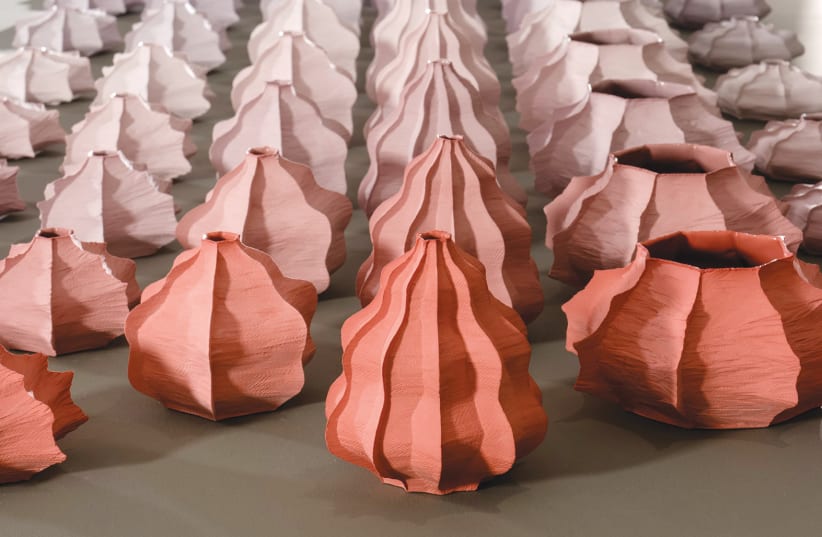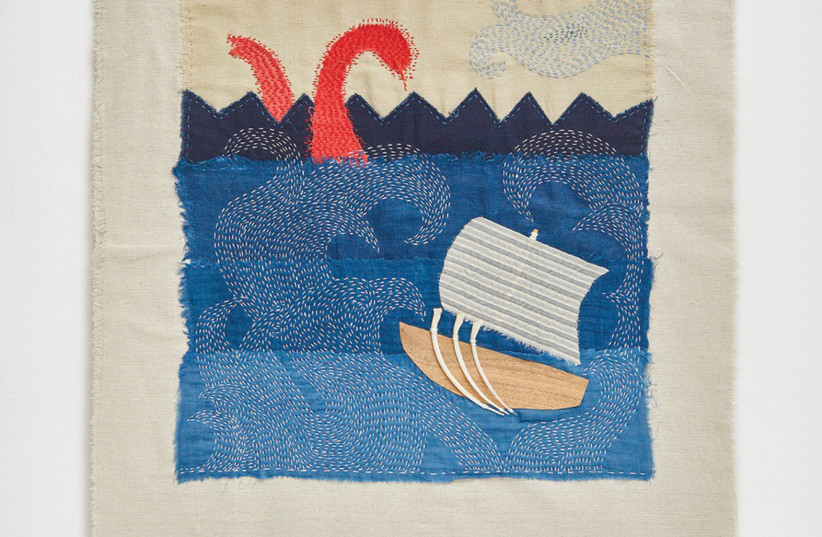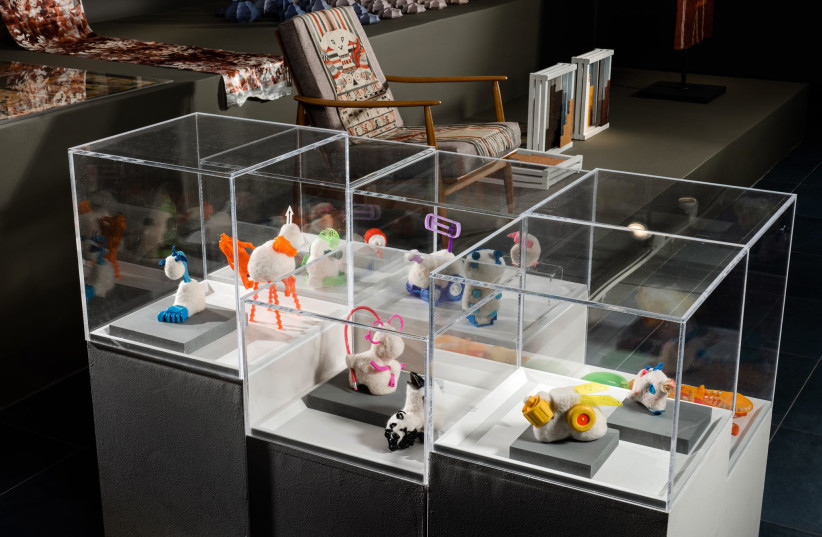The Ashdod Museum of Philistine Culture is the only one in the world devoted to the culture of these ancient people. “We Israelis know them as invaders, plotters, [the] uncircumcised,” museum head Mira Levy tells me. The core exhibition begins with a figure of a Philistine warrior, then quickly changes to depict his entire family and the epic tale of why they left their island of Caphtor (possibly Crete), and how they lived here for centuries.
“We Israelis know them as invaders, plotters, [the] uncircumcised.”
Mira Levy
They came because their homes were destroyed, “a reason everyone can relate to,” Levy adds as she leads me between the exhibits. All of them coupled with English texts (and braille), with some archeological findings presented as large-sized replicas, allowing visitors to touch and turn them around. An interactive video allows a child to stand and topple the columns of a Philistine temple – just as Samson did.
Craft of Disappearance, curated by Galit Gaon and Tom Cohen, invited 22 designers to gain inspiration from this rich legacy by opening a dialog with archeologists and other experts. The current Ashdod port, to name but one example of how the very distant past touches the here and now, hosts an ancient paint factory where the color argaman (a now unknown shade of red or purple) was produced from snails.
Ori Shifrin Anavi was inspired to present a series of vessels, which change their color from the aforementioned color to that of techelet (likely light blue). The color Jewish culture associates with sacredness. Mordechai, to name one mythical character, is dressed in garments of both colors to represent him having both worldly power and inner holiness.
Nearby, Maria Merfeld presents five pieces titled The Telling of Days, depicting what we might have found had the Philistine left behind textiles or paintings that tell their side of history. As things are now, most of what we know of them today is inferred from what little we found and textual sources that made the very name a stand-in for bad behavior.
This urge to connect to the deep-past of this region and introduce artistic devices to bridge gaps in knowledge seems to be a growing trend in Israeli art.
AT THE Bible Lands Museum Jerusalem, Digging Down – Art of the Pre-Future closed in early April. That exhibition, curated by Shira Friedman, brought together 42 artists who took on archaeology with all its complex layers.
Artist Assi Meshullam and musician Talia Kliger, to name but one interesting collaboration, created modern chants to the Baal and Astarte for it.
Recently, curator Bar Yerushalmi worked with the Arad Contemporary Art Center on a desert walk following the theory of an ancient path connecting the Kingdom of Judah and that of Edom. A group effort introduced scholars, artists, and musicians to one another on the vast desert road.
The prophet Amos himself informs his audience that, from God’s point of view, everybody on this land follows only him. “Have I not brought up Israel from the land of Egypt?” Amos asks, “and the Philistines from Caphtor and the Arameans from Kir?” (Amos 9:7)
“Have I not brought up Israel from the land of Egypt? And the Philistines from Caphtor and the Arameans from Kir?”
Amos 9:7
In Craft of Disappearance, the assembled artists present a range of very different works – from colorful emotional ones like The Telling of Days, which offers a better history than the one we actually possess – to very intellectual works like the glass resin fishing nets displayed by Aram Amir Pundak and Avia Haimi.
“We wanted to deal with something that has been around for thousands of years and never changed – like fishing nets,” Pundak told me.
Ancient fishing nets did not survive to our own times, but our own nets, made from plastics, will survive for many centuries. While very light and small, the works invite the viewer to contemplate the immense impact humanity has on the sea, and how radically different it is now when compared to the days when Philistine sea-farers followed the bird painted on their mastheads here.
"Moshe Dayan thought the Philistine bird was the goose, because that bird can fly, walk and swim," said artist and museum guide Veronique Polka, adding that it makes it a good totem animal for an invading culture.
“Children love the fishing net artwork,” museum guide Tracy Kaplan-Gross informs me, “it reminds them of doodling.”
“It’s interesting to see what people focus on when they see 3,000 year old objects,” the Long Island native said. “Upstairs we don’t show art; these are concrete, useable objects. How long will these art-works last? Nobody knows.”
A LOT of thought went into this exhibition. One example is how the art video Wearing Military Clothing in Five Ways or Less by David Weksler – where he pretends to be a future-man trying to figure out how people in our own times wore military uniforms – is placed next to String and Connections by Polka. The latter is a work which explores how, in Philistine culture, red tassels were hung on the skirts of warriors to mark rank. The more tassels a person had, the higher-ranking officer he was.
Some works connect to past exhibitions at the museum. Rama Amir, for example, created a woman’s dress, which is an attempt to imagine a rite of passage between mother and daughter in Philistine culture. In such a tradition, a single dress could be handed down across time. With each young woman fixing this or that tear. This brought to my mind Human Tissue by Efrat Dagani, which was shown at the same museum last year as part of Transition Object (also curated by Gaon and Cohen).
Dagani was focused on unique pieces of clothing she found at various flea markets, which were removed from their cultures of origin. Amir seems to present a much more wide-reaching solution to the same problem, lacking material connections to the past in a rapidly changing society.
Shira Shoval said that she used rejected wool, taken from a tallit-making factory in Bnei Brak, “to restore humanity to what was not meant to have lasting value, like these toys.”
She pointed out that such items “made in faraway places in an industrial fashion” are meant “to quickly break down to pieces.”
“I’ve taken part in many exhibitions, but what has happened here is very rare,” she said.
She describes a unique warmth in the year-long working process that brought artists on special tours in Ashdod and around it, given by leading experts in archeology and other sciences.
Not only was there a wish for artists to learn, the museum offered payment for works. A generosity which is not always the norm here, where artists are often told showing their work is payment in its own right. So, who is the real Philistine here?
‘Craft of Disappearance’ at the Corinne Mamane Museum of Philistine Culture in Ashdod (16 Hashayatim St.). Hours are Sunday, Tuesday, Wednesday and Thursday from 9 a.m. to 4 p.m., Monday from 9 a.m. to 8 p.m., Friday from 10:30 a.m. to 1:30 p.m. and Saturday from 10:30 a.m. to 1:30 p.m. Group visits can be arranged by calling Aviram Elisha at 08-867-9720. The exhibition will be open for a year.


